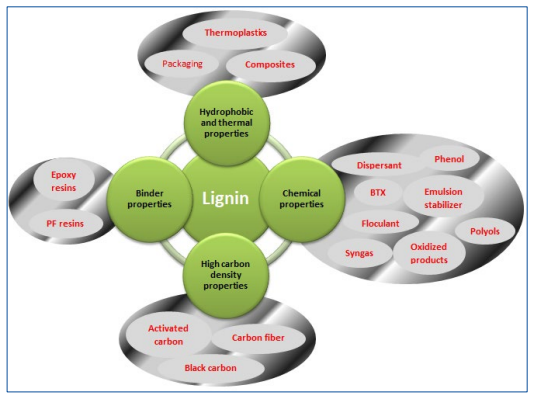Sustainable lignin valorization
Lignin is the second most abundant biopolymer of land-based biomass, with great potential as a source of many aromatic chemicals and building block chemicals. Its full exploitation can increase the profitability of many lignocellulosic biorefineries and produce biobased products that can contribute to reducing GHG emissions from those of equivalent fossil-based processes. Despite the great potential for biobased materials in several industrial sectors, one main obstacle to full exploitation is the complex structural variations of isolated lignins due to the natural variability among the different biomass feedstocks and differences in biorefinery layout technologies: molecular weight distributions, functional group contents and their distributions as well as the residual impurities are specifically affected.
Large volume and low specific value applications of lignin include the production of energy and biofuels. In contrast, small volume and higher value-added applications include the production of chemicals through lignin depolymerization and specific functionalization.
While the most common kraft lignin from the pulp paper industry currently accounts for 170 kton/year, additional important current lignins include lignosulfonates, alkali lignin, acid hydrolysis lignin, steam explosion lignin and organosolv lignin. Recently, the development of novel pretreatment technologies at industrial scale, such as steam-assisted pretreatment or solvent-assisted biomass fractionation, has led to novel lignins from novel feedstocks with characteristics that are suitable for more targeted potential applications.
The present review includes the analysis of the available technical lignins with a special focus on novel lignins stemming from new technologies and producers, including market volumes at the global level. The report details the chemical features of the available technical lignins and provides an overview of the main processes to achieve final products. These includes polymeric materials (phenolic resins, polyurethane), carbon fibres, BTX, fuels, aromatic lignin monomers and many others. A market overview is provided to assess specific trends of penetrations and current limits.
At the European level, many R&D projects have been funded in the last 10 years for the conversion of lignins to final products. The report includes an overview of the most recently funded lignin exploitation projects.
Future trends and research recommendations are finally drawn on the basis of the accumulated facts.



